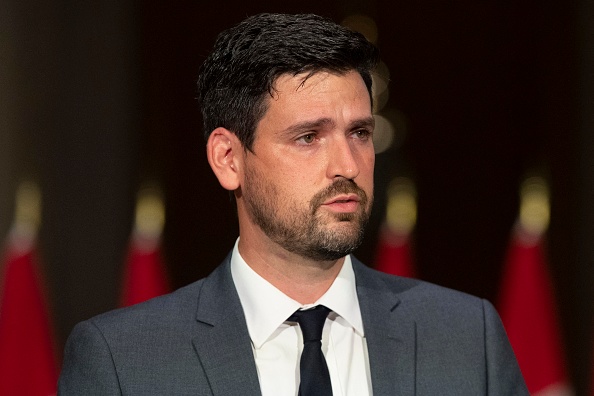
Minister of Immigration, Refugees and Citizenship, Sean Fraser speaks during a press conference in Ottawa on October 26, 2021. (Photo by Lars Hagberg / AFP via Getty Images)
By Anthony Furey
Commentary
One of the first major pledges of the Liberal government of Prime Minister Justin Trudeau upon forming government in 2015 was to bring in a large number of Syrian refugees within a short period of time.
There was both political and public will to see this happen, as Canadians watched with concern as war in Syria caused a growing refugee crisis.
But there was one set of voices that at one point in the process wanted to temporarily pause the rush of arrivals to Canada. They weren’t anti-immigrant voices. In fact, it was the opposite. Refugee resettlement agencies were, for a brief period, calling on the feds to slow things down.
Bringing in tens of thousands of people so rapidly was causing logistical challenges, they said. They didn’t have the staffing resources and they hadn’t identified adequate housing for the refugees.
It was an interesting little footnote to that whole episode, learning that the most pro-refugee groups out there knew there were limits to the number of people you can bring into Canada in an orderly and successful fashion within a certain time frame.
This microcosm of an incident now appears to be happening on a much larger scale, as Canadians from various sectors and walks of life are asking critical questions about the Liberals’ growing targets for immigration more broadly.
The new plan is to bring in 465,000 permanent residents in 2023, 485,000 in 2024, and a whopping 500,000 by 2025. It’s a big leap and it’s happening quickly. To give a sense of how much that target has ballooned, the 2016 number was 250,000 newcomers. We’re doubling the volume in under 10 years.
There was a time when people were sheepish about publicly critiquing immigration numbers as being “too much.” Anyone who criticized the volume of the intake was seen as also criticizing the country of origin or race and ethnicity of the newcomer. (And of course that remains the motivation for some people’s criticism of immigration.)
But concerns around immigration targets have now become mainstream as Canadians grapple with challenges that include housing costs, health-care systems in tatters, and worsening congestion.
A public opinion survey conducted by Leger in November found that half of respondents believe Trudeau’s new targets are too high.
It’s no wonder. Let’s use the City of Brampton as an example. The 2021 census listed the west GTA community as the country’s fastest-growing urban centre. A stone’s throw away from Pearson International Airport, Brampton is the home of choice for many newcomers yet it is underserved in terms of infrastructure.
For years, there has been talk of getting the city a second full-service hospital. That project is only now being sped up thanks to the light shone on hospital capacity issues by the pandemic. However, construction isn’t expected to start until late this year with a completion date of 2027. The city will only grow between now and then.
Another challenge Brampton is facing is that its urban boundary hits up against a region known as the Greenbelt. This is land that’s largely protected from development for a variety of reasons, some of them environmental. But the explicit purpose of the Greenbelt is also to contain the urban sprawl of the Toronto area. It’s literally about forcing a growing population to increasingly live cheek by jowl.
Progressive thinkers say the solution is to build up, not out. Their vision to tackle congestion and the housing crisis is one where we all live close to where we work, walking or bicycling to our destinations.
But economists and real estate industry experts have been pointing out for months now that we face a shortage of millions of housing units. Converting a few standalone houses into triplexes isn’t going to cut it.
The Liberals are aware that rising immigration numbers disproportionately affect cities. “The plan also brings an increased focus on attracting newcomers to different regions of the country, including small towns and rural communities,” the government notes in a press release from last November. The question though is whether people will choose these smaller communities.
Whatever happens, something’s got to give. You can’t be slow to build services that people rely on while at the same time be faster at bringing in people to use those services.
This is the math that more Canadians are doing, and they’re quickly learning it doesn’t add up.
Views expressed in this article are the opinions of the author and do not necessarily reflect the views of NTD Canada.